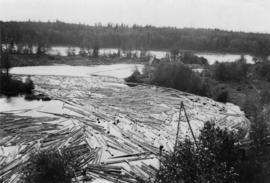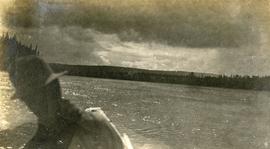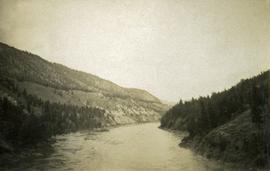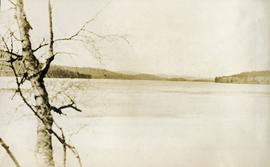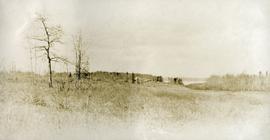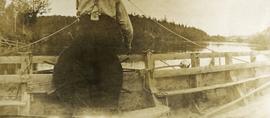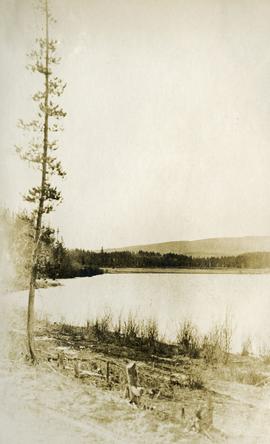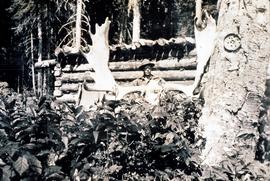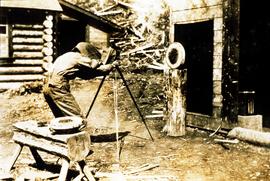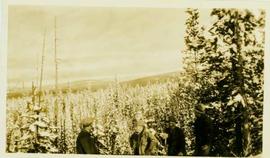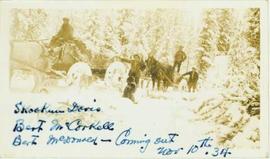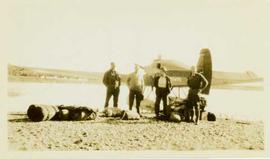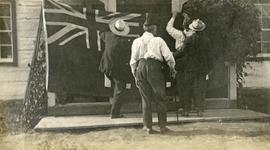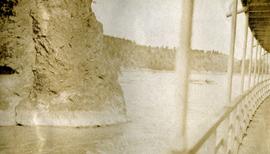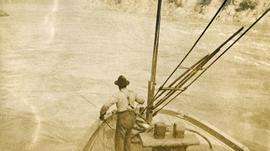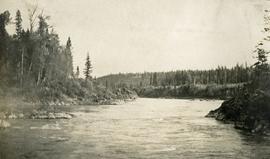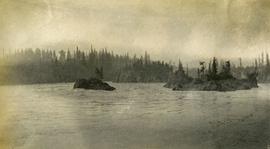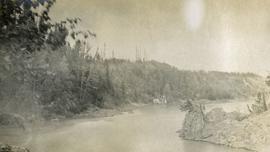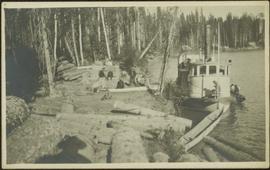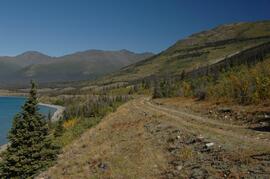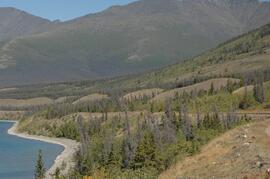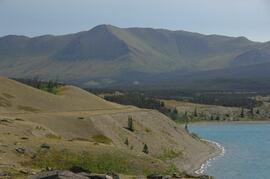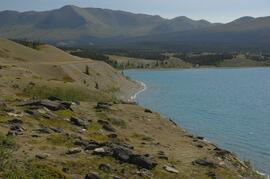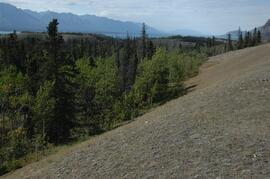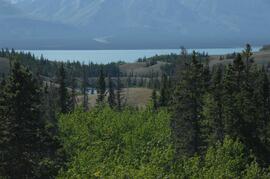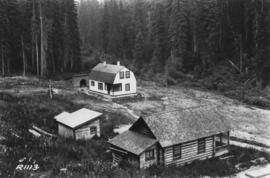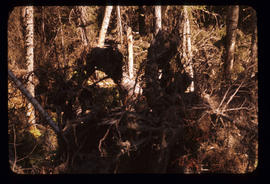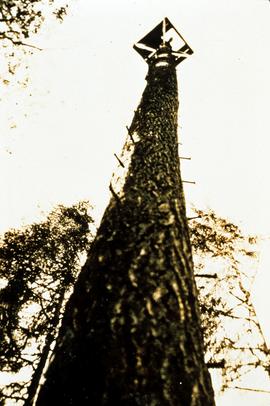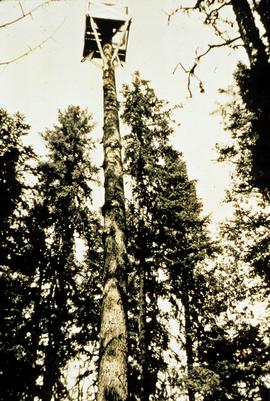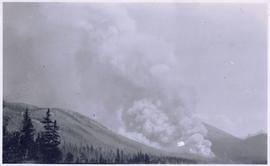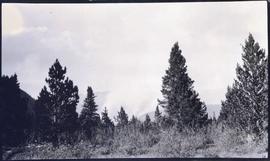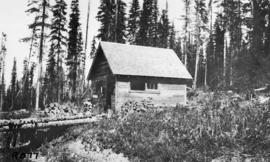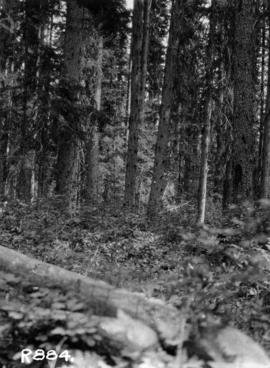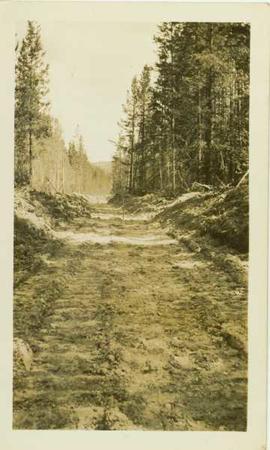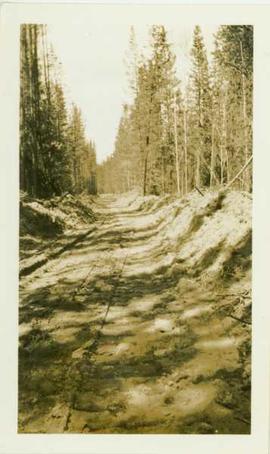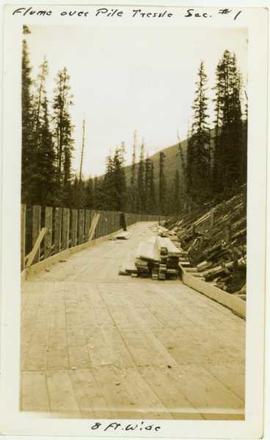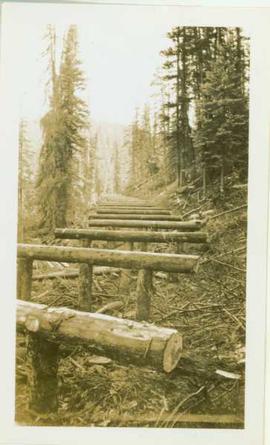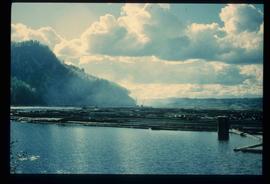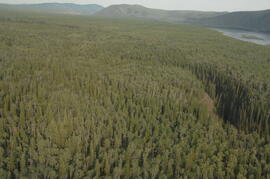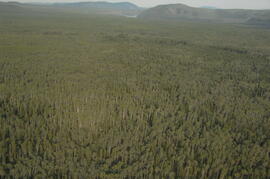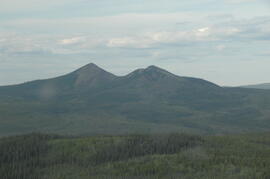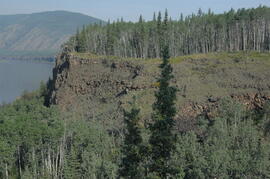Photograph depicts a Fraser River backchannel with logs at Peden Hill sawmill. The jackladder to the sawmill is visible on the bottom right.
Photograph depicts view of the river from a boat. There is a silhouette of a person wearing a hat in the foreground.
Photograph depicts a view of the Fraser River bordered by sparsely treed hills. Album notes: "views of Chilcotin".
Photograph depicts a lake. Photograph is framed by a deciduous tree on the left. Forest and rolling hills in the background.
Photograph depicts a view of the Fraser Lake ferry house from a distance.
Photograph depicts view from behind the ferryman and ship's wheel. Fraser Lake and treed hills in the background.
Photograph depicts roughly cleared land in the foreground, a lake and rolling forested hills in the background.
Photograph depicts the lake from the water's edge. Low forested hills in the background.
Item is a photograph of a copy print that has been reproduced as a slide, resulting in low photographic quality. Location of original photograph unknown.
Frank Dickson was a UBC pathologist who studied heart rot in balsam at Aleza Lake Experimental Station (and also gave great haircuts).
Item is a photograph of a copy print that has been reproduced as a slide, resulting in low photographic quality. Location of original photograph unknown.
Frank Dickson was a UBC pathologist who studied heart rot in balsam at Aleza Lake Experimental Station (and also gave great haircuts).
Item is a photograph of a copy print that has been reproduced as a slide, resulting in low photographic quality. Location of original photograph unknown.
Frank Dickson was a UBC pathologist who studied heart rot in balsam at Aleza Lake Experimental Station (and also gave great haircuts).
Photograph depicts four unidentified men standing together on a hillside with a winter forest landscape in the distance. Handwritten annotation on verso of photograph reads: "Snow scene on trail".
Photograph depicts four men posed within or beside two horse drawn carriages in a winter forest landscape. Annotation on recto of photograph reads: "Skookum Davis (?) Bert McCorkell, Bert McDonald - Coming out Nov. 10th, 1934"
Photograph depicts four men standing in front of a float plane on the shore of a lake surrounded by their bags. Annotation on verso of photograph reads: "Leaving Stuart Lake by plane, Left to right: Mason, Keith, Ferguson, MacMillan (Pilot)"
Photograph depicts four men pinning a "Union Jack" flag to the exterior of a building.
For July 1-7, 2009, Dr. Paul Sanborn did the first soils field research at the Fort Selkirk volcanic field in central Yukon, with helicopter support and funding from the Yukon Geological Survey.
Initial findings were published in the 2009 edition of Yukon Exploration and Geology, but this paper did not include most of the laboratory data:
Sanborn, P., 2010. Soil reconnaissance of the Fort Selkirk volcanic field, Yukon (115I/13 and 14). In: Yukon Exploration and Geology 2009, K.E. MacFarlane, L.H. Weston and L.R. Blackburn (eds.), Yukon Geological Survey, Whitehorse, Yukon. pp. 293-304. https://emrlibrary.gov.yk.ca/ygs/yeg/2009/2009_p293-304.pdf [Note that in Fig. 1, the labels for Camp 1 and Camp 2 on map are transposed; Camp 1 should be to the east of Camp 2.]
In July 2009, Dr. Paul Sanborn undertook the first soils field research at the Fort Selkirk volcanic field in central Yukon, with helicopter support and funding from the Yukon Geological Survey. This file includes digital photographs of the 2009 field work at the Ft. Selkirk site. Some of the digital photographs have been annotated as PDFs.
- Ft Selkirk 110114069.xls [particle size analysis data, CANTEST]
- S1090final.xlsx [chemical analysis data, Ministry of Forests & Range, Analytical Chemistry Laboratory]
- S1112final.xlsx [chemical analysis data, Ministry of Forests & Range, Analytical Chemistry Laboratory]
- Ft Selkirk 2009 soils data (updated Sept 15, 2010 and April 10, 2023).xls [consolidated lab data for all 2009 samples]
Photograph depicts a view of the rocky shores of Fort George Canyon from the deck of a steamship.
Photograph depicts a view of the swirling waters of Fort George Canyon from the deck of a steamship.
Photograph depicts a view of Fort George Canyon.
Photograph depicts a view of Fort George Canyon from the shore. A steamship is in the centre of the river.
Photograph depicts misty waters and small islands in the river.
Photograph depicts Fort George Canyon from a lofty view. A small building is situated on the river's edge.
Series consists of records pertaining to Harry Coates work and training as a BC Forest Service Research Technician. Series includes documentation for various Sx trials and experimental plots (E.P.) Harry Coates worked on.
Photograph depicts men on river boat and small canoe floating just off shore. Men sit and stand on shore among square bales and large cut lumber. Forest in background. Handwritten annotations on recto of photograph: "Fort Fraser wooding up at Giscome Portage", "Chilco at Giscome Portage".
Item is a copyprint reproduced from the British Columbia Forest Service photographic records held at BC Archives.
Slide depicts a heavily forested area with fallen logs, likely at the Aleza Lake Experiment Station.
Series consists of materials reflecting Harry Coates life-long dedication and activism for sustainable forest management. Series also reflects Harry Coates' interest in forest history; series includes old forest industry records collected by Harry Coates including a timber sales ledger and timber license.
Item is a photograph of a copy print that has been reproduced as a slide, resulting in low photographic quality. Location of original photograph unknown.
"A large Douglas-fir veteran on the ridge above the camp towered above the Spruce-Balsam forest. A decision was made to convert it into a forest fire lookout. This photo shows a climber going up to top it. After the top was removed, a platform was built. Large spikes were used to provide steps." --from the notes of Ralph Schmidt in accompanying file
Item is a photograph of a copy print that has been reproduced as a slide, resulting in low photographic quality. Location of original photograph unknown.
"A large Douglas-fir veteran on the ridge above the camp towered above the Spruce-Balsam forest. A decision was made to convert it into a forest fire lookout. This photo shows a climber going up to top it. After the top was removed, a platform was built. Large spikes were used to provide steps." --from the notes of Ralph Schmidt in accompanying file
Caption of back of photograph states: "R877 Forest Branch Cabin X9696"
Photographer's photo number R884. No caption on back of photograph to glean further information. Title provided based on contextual information from related photographs and documents.
Photograph depicts a access road leading through a forested area.
Photograph depicts an access road leading through a forested environment.
Photograph depicts three men and a dog on the streambank, several horses loaded with packs on the opposite bank.
Photograph depicts a wooden flume being constructed along a hillside through a forest landscape. Handrwitten annotation on recto of photograph: "Flume over pile trestle, sec. #1, 8ft. wide"
Photograph depicts a line of wooden piles that have been driven into the ground and lead through a forested landscape. Handwritten annotation on verso of photograph: "part of flume construction piles driven down to refusal".
Image depicts numerous tree logs floating on a body of water. The location is uncertain, but is likely Eaglet Lake.
